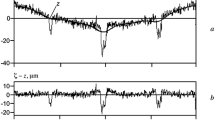Abstract
A method is given to calculate the surface layer parameters: u * (friction velocity) and T * (temperature scale) from wind speed and temperature profiles.
The problem is formulated as a minimization of a least-square function, which is constructed from the difference between the measured profiles and the well-known Kansas profile relations.
The wind speed and temperature profiles are treated simultaneously in this procedure. All the available wind speed and temperature measurements are used in order to reduce the effect of measurement errors.
Estimates of the goodness of fit and confidence limits on the estimated parameters are discussed.
The method has been applied to data obtained during experiments in a wide variety of conditions: Project Prairie Grass, experiments over Lake Flevo and experiments at the meteorological tower at Cabauw, the last two in the Netherlands.
Similar content being viewed by others
References
Barad, M. L.: 1958, ‘Project Prairie Grass, a Field Program in Diffusion, (three Volumes)’, Geophysical Research Papers 73, AFCRC-TR-58-235.
Bard, Y.: 1974, Nonlinear Parameter Estimation, Academic Press.
Busch, N. E.: 1973, ‘On the Mechanics of Atmospheric Turbulence’, Workshop on Micrometeorology, Am. Meteorol. Soc., pp. 1–65.
Businger, J. A., Wyngaard, J. C., Izumi, Y., and Bradley, E. F.: 1971, ‘Flux Profile Relationships in the Atmospheric Surface Layer’, J. Atmospheric Sci. 28, 181–189.
Driedonks, A.: 1977, ‘Case Studies of Atmospheric Turbulence during Early Morning Inversion Rise’, (to be published).
Klug, W.: 1967, ‘Determination of Turbulent Fluxes of Heat and Momentum from the Wind Profile’, Quart. J. Roy. Meteorol. Soc. 93, 101–104.
Krügermeyer, L.: 1975, ‘Vertikale Transporte von Impuls, sensibler und latenter Wärme aus Profilmessungen über dem tropischen Atlantik während APEX’, Berichte des Inst. für Radiometeorologie und maritime Meteorologie, Hamburg.
Ling, C.: 1976, ‘On the Calculation of Surface Shear Stress Using the Profile Method’, J. Geophys. Res. 81, 2581–2582.
Marquardt, D.: 1963, ‘An Algorithm for Least-Squares Estimation of Nonlinear Parameters’, J. Soc. Indust. Appl. Math. 11, 431–441.
Paulson, C. A.: 1970, ‘The Mathematical Representation of Wind Speed and Temperature Profiles in the Unstable Atmospheric Surface Layer’, J. Appl. Meteorol. 9, 857–861.
Tennekes, H.: 1973, ‘The Logarithmic Wind Profile’, J. Atmospheric Sci. 30, 234–238.
van Ulden, A. P., van der Vliet, J. G., and Wieringa, J.: 1976, ‘Temperature and Wind Observations at Heights from 2 to 200 m at Cabauw 1973’ Roy. Neth. Met. Inst., Scientific Report 76-7.
Wieringa, J.: 1972, ‘Tilt Errors and Precipitation Effects in Trivane Measurements of Turbulent Fluxes over Open Water’, Boundary-Layer Meteorol. 2, 406–426.
Wieringa, J.: 1974, ‘Comparison of Three Methods for Determining Strong Wind Stress over Lake Flevo’, Boundary-Layer Meteorol. 7, 3–19.
Author information
Authors and Affiliations
Rights and permissions
About this article
Cite this article
Nieuwstadt, F. The computation of the friction velocity u * and the temperature scale T * from temperature and wind velocity profiles by least-square methods. Boundary-Layer Meteorol 14, 235–246 (1978). https://doi.org/10.1007/BF00122621
Revised:
Issue Date:
DOI: https://doi.org/10.1007/BF00122621




